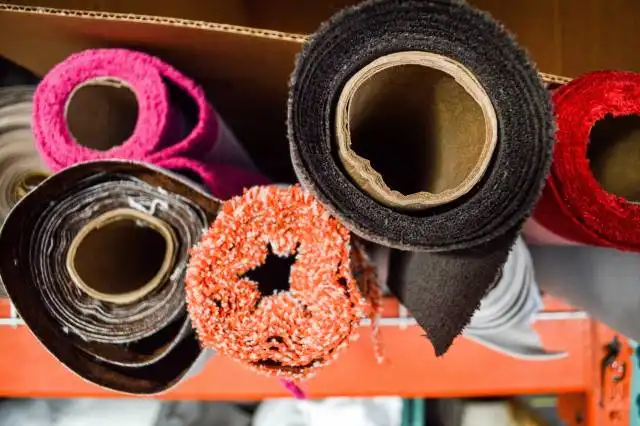Start a Carpet Installation Business
Riding the Magic Carpet to a Lucrative Business Venture
| Updated


CARPET INSTALLATION BUSINESS
Unleash your inner Aladdin and get ready to take a magic carpet ride with your own carpet installation business! This enterprise is all about measuring, cutting, and laying carpets perfectly in homes, offices, or any space that desires a touch of soft elegance underfoot. For experienced DIY folks who can handle tricky corners and stairs, it's nothing less than hopping aboard a lucrative genie's lamp. Remember, a world without carpets would truly "suck" - just ask any vacuum cleaner!
Jump to Business Plan
RELATED BUSINESS IDEAS
Browse ALL Home Improvement & Repair Solutions Business Ideas
Discover Your Perfect Domain
Unlock the door to your online success with our hand-picked selection of premium domain names. Whether you're starting a new venture or rebranding an existing one, the right domain can set the tone for your digital presence. Browse through our curated list, each with its unique potential to enhance your brand's visibility and credibility.
CARPET INSTALLATION MINI BUSINESS PLAN
This a quick reality check to help you identify the strengths and weaknesses of your business concept before you dive in.
Expected Percent Margin:
- Gross Margin: 40-50%
- Net Profit Margin: 10-15%
Earnings Expectations:
- Daily Earnings: $300 - $800
- Weekly Earnings: $1,500 - $4,000
- Monthly Earnings: $6,000 -$16,000
- Annual Earnings: $72,000 - $192,000
Actions to Hit Those Numbers:
Inventory Management:
- Initial Suppliers: Build relationships with reliable suppliers of various types and styles of carpeting.
- Margins: Aim for a gross margin of at least 40% when reselling carpeting.
Marketing and Customer Acquisition:
- Website: Have a professionally made website showcasing your works and services.
- Digital Marketing: Invest approximately $500-$1000 per month in online advertising.
Tools and Equipment:
- Initial Investment: Your initial shopping list may include knee kickers, tuck tools, heat bond irons costing between $1,000 - $5,000.
Job Execution:
- Staff: Hire skilled labor. A team of 2-3 might be sufficient to begin with.
- Job Execution: Aim to complete 1-2 installations per day, with average job price between $500 - $1,000.
Business Administration:
- Insurance: Shop around for the best rates on liability insurance.
- Training: Invest in any necessary training to keep your skills up to date.
Cost Control:
- Fuel: Budget for travel expenses as this is a mobile business.
- Waste Disposal: Account for costs to properly dispose of old carpet, if part of your services.
NOTE: These are approximations and can vary based on scope of work, region, and suppliers. Always consult business or financial advisor for personalized advice.
NOT WHAT YOU HAD IN MIND? Here are more ideas



Browse ALL Home Improvement & Repair Solutions Business Ideas
Grab Your Business Website Name
Before you get caught up in the whirlwind of setting up your business, invest in a domain name. It's a small but significant step that lays the foundation for your brand and makes it easier for customers to find and trust you. Just like you wouldn't build a house without securing the land first, don't build a business without securing your domain name.
"Why? Can't that wait?" Here's why it shouldn't
Step 1: Determine if the Business is Right for You
Breakdown of Startup Expenses
Before starting a carpet installation business, it is important to understand the startup costs associated with the venture. This includes the cost of renting or purchasing a workspace, purchasing the necessary tools and supplies, and hiring employees if needed. Additionally, you may need to pay for insurance, licensing, and other fees. It is important to have a clear understanding of the startup costs before beginning the business.
Breakdown of Ongoing Expenses
Once the business is up and running, there are ongoing expenses to consider. This includes the cost of materials, such as carpet, padding, and adhesive. Additionally, you will need to factor in the cost of utilities, such as electricity, water, and gas. You may also need to pay for marketing and advertising, as well as any other fees associated with running the business.
Examples of Ways to Make Money
Carpet installation businesses can make money in a variety of ways. This includes charging for installation services, selling carpet and other materials, and offering additional services such as cleaning and repairs. Additionally, you can offer discounts for bulk orders or for customers who refer others to your business. It is important to find ways to maximize profits while still providing quality services.
Step 2: Name the Business
Choosing a name for your business is an important step in the process of starting a carpet installation business. It should be something that reflects the type of business you are running and something that will be memorable to potential customers. When choosing a name, consider the following tips:
Keep it simple. A name that is too long or complex can be difficult for customers to remember.
Make it unique. Choose a name that stands out from the competition and is not already taken by another business.
Consider the type of business. If you are a carpet installation business, try to include words such as “carpet” or “installation” in the name.
Consider the area you are in. If you are in a large city, you may want to include the city name in the business name.
Think about the future. Choose a name that can grow with your business as you expand into other areas or services.
Check for domain availability. Once you have chosen a name, check to see if the domain name is available. This will help you create a website and other online presence for your business.
Check for trademark availability. Before you settle on a name, make sure it is not already trademarked by another business. This can help you avoid legal issues down the line.
Get feedback. Ask friends and family for their opinion on the name you have chosen. This can help you make sure it is something that resonates with potential customers.
Step 3: Obtain Necessary Licenses and Permits
Before you can start your carpet installation business, you must obtain the necessary licenses and permits. Depending on where you live, this may include a business license, a contractor’s license, and a sales tax permit. You may also need to obtain a zoning permit if you plan to operate your business from a physical location. Additionally, you may need to obtain a certificate of occupancy if you plan to use a commercial space. It is important to research the local laws and regulations in your area to ensure that you have all the necessary licenses and permits.
Step 4: Secure Financing
Once you have obtained the necessary licenses and permits, you will need to secure financing for your business. This may include taking out a loan, using your own savings, or seeking out investors. It is important to have a detailed business plan in place before you approach potential lenders or investors. Additionally, you should be prepared to provide financial statements and other documents that demonstrate the viability of your business. Once you have secured the necessary financing, you can move forward with setting up your business.
Step 5: Purchase Equipment and Supplies
In order to start your carpet installation business, you will need to purchase the necessary equipment and supplies. This may include carpeting, tools, and other materials. You may also need to purchase a vehicle to transport your supplies and equipment. Additionally, you may need to purchase office supplies, such as a computer, printer, and other office equipment. It is important to research the best deals on supplies and equipment in order to get the most value for your money.
Step 6: Market Your Business
Once you have secured financing and purchased the necessary equipment and supplies, you will need to market your business. This may include creating a website, advertising in local newspapers and magazines, and attending trade shows. You should also consider using social media to reach potential customers. Additionally, you may want to offer discounts or promotions to attract new customers. It is important to create a comprehensive marketing plan to ensure that your business is reaching the right audience.
Step 7: Hire Employees
If you plan to expand your business, you may need to hire employees. This may include carpet installers, salespeople, and administrative staff. When hiring employees, it is important to thoroughly vet each candidate to ensure they are the right fit for your business. Additionally, you should be prepared to provide competitive wages and benefits. It is also important to have a clear job description and expectations for each employee.
Step 8: Set Up Accounting System
In order to manage your finances, you will need to set up an accounting system. This may include using a software program or hiring an accountant. It is important to track your income and expenses in order to stay on top of your finances. Additionally, you should have a system in place to track customer payments and invoices. It is also important to set up a budget to ensure that you are staying within your financial means.
Step 9: Develop a Business Plan
Finally, you should develop a business plan for your carpet installation business. This should include a detailed description of your business, your goals, and your strategies for achieving those goals. Additionally, your business plan should include a financial plan, a marketing plan, and a risk management plan. A business plan will help you stay organized and focused on the long-term success of your business.
Step 4: Create a Business Plan
Creating a business plan is an essential step in starting a carpet installation business. A business plan will help you to identify the goals of your business and the steps needed to reach those goals. It should include a detailed description of the services you will offer, a marketing plan, a financial plan, and a timeline for achieving your goals. Additionally, it should include an analysis of the competitive landscape, an assessment of the potential risks and rewards associated with the business, and a plan for how you will manage the business. A business plan should also include a budget for startup costs, such as equipment, materials, and labor, as well as ongoing costs, such as rent, insurance, and taxes. Finally, it should include a plan for how you will generate revenue and make a profit.
Step 5: Obtain Licenses and Permits
Before you can open your business, you will need to obtain the necessary licenses and permits. Depending on the state and local laws, you may need to obtain a business license, a contractor’s license, and/or a sales tax permit. Additionally, you may need to obtain a zoning permit if you plan to operate out of a physical location. It is important to research the laws in your area and obtain the necessary licenses and permits before you start your business.
Step 6: Purchase Equipment and Supplies
Once you have obtained the necessary licenses and permits, you will need to purchase the necessary equipment and supplies for your business. This may include tools, such as a carpet cutter, a knee kicker, and a power stretcher, as well as materials, such as carpet, padding, and adhesive. You may also need to purchase office supplies, such as a computer, printer, and phone. Additionally, you may need to purchase safety equipment, such as protective eyewear and gloves. Make sure to research the best options for your business and purchase the necessary equipment and supplies before you start your business.
Step 7: Market Your Business
Once you have obtained the necessary licenses and permits and purchased the necessary equipment and supplies, you will need to market your business. This may include creating a website, creating business cards, and/or advertising in local newspapers and magazines. Additionally, you may want to join local business associations and attend trade shows to network and meet potential customers. Finally, you may want to consider offering discounts or promotions to attract new customers.
Step 8: Hire Employees
If you plan to expand your business, you may need to hire employees. This may include hiring carpet installers, salespeople, and/or office staff. When hiring employees, make sure to research the laws in your area and create a job description that outlines the duties and responsibilities of the position. Additionally, you may want to consider offering benefits, such as health insurance and paid time off.
Step 9: Track Finances
Finally, you will need to track your finances. This may include creating a budget and tracking your income and expenses. Additionally, you may want to consider using accounting software to help you manage your finances. Make sure to track your finances regularly to ensure that your business is profitable.
Step 5: Secure Financing
Securing financing for a new business can be a daunting task. It is important to research all of the financing options available to you. You may be able to secure a loan from a bank or other financial institution, or you may be able to use your own savings to get started. It is important to consider the interest rates and repayment terms of any loan you take out, as well as the potential tax implications of taking out a loan. Additionally, you may want to consider crowdfunding as an option for financing your business. Crowdfunding is a great way to get the word out about your business and to raise money quickly. You can also look into grants and other forms of financing that may be available to you. Once you have secured the necessary financing, you can move on to the next step.
Step 6: Purchase Supplies and Equipment
Once the business is registered, the next step is to purchase the necessary supplies and equipment. This will include items such as carpeting, padding, tools, and installation supplies. Carpeting and padding can be purchased from a variety of sources, including carpet wholesalers, home improvement stores, and online retailers. It is important to compare prices and quality when making these purchases. Tools and installation supplies can also be purchased from a variety of sources, including hardware stores, home improvement stores, and online retailers. It is important to purchase quality tools and supplies that will last and make the installation process easier. Additionally, it is important to purchase enough supplies to complete the job.
Step 7: Obtain Necessary Licenses and Permits
Before beginning operations, it is important to obtain the necessary licenses and permits. Depending on the state and local regulations, this may include a business license, a contractor’s license, and a sales tax permit. Additionally, some states may require a special license for carpet installation businesses. It is important to research the specific requirements for the state and local area.
Step 8: Market the Business
Once the business is registered, licensed, and supplied, the next step is to market the business. This can be done through a variety of methods, including creating a website, advertising in local publications, and networking with other businesses. Additionally, it is important to create a portfolio of completed projects to showcase the quality of the work.
Step 9: Hire Employees
If the business is expected to grow, it may be necessary to hire employees. This will require researching the local labor laws and regulations, as well as creating job descriptions and interviewing potential candidates. Additionally, it is important to provide training and support to ensure that employees are able to perform their duties properly.
Step 7: Market Your Business
Marketing your business is essential to getting the word out and bringing in customers. You should create a business website and social media accounts to showcase your services and products. You should also consider creating a blog or newsletter to keep customers informed about your business and the services you offer. Additionally, you should consider creating promotional materials such as flyers, business cards, and brochures to distribute to potential customers. You should also consider advertising in local newspapers, magazines, and radio stations. Finally, you should consider attending local events and trade shows to promote your business and network with potential customers.
Step 8: Set Up a Business Location
When it comes to setting up a business location, there are a few things to consider. First, you need to decide if you want to run your business from home or rent a space. If you choose to rent a space, you need to make sure it is in a good location with plenty of foot traffic. You should also consider the size of the space you need, as well as the cost of rent. Additionally, you should make sure the space is compliant with all local zoning laws and regulations.
Once you have found the perfect location, you will need to set up the space. This includes purchasing any necessary equipment, such as a carpet installation machine, and furniture, such as tables and chairs. You will also need to make sure the space is properly lit and heated, as well as properly ventilated. Additionally, you should make sure the space is secure and safe for your customers and employees.
Finally, you will need to make sure the space is properly branded with your business logo and other branding elements. This will help customers recognize your business and help you stand out from the competition. Additionally, you should make sure the space is properly decorated and inviting for customers. This will help create a positive atmosphere and encourage customers to return.
Step 9: Hire Employees
The final step in starting a carpet installation business is to hire employees. It is important to hire employees who have experience in the field and who are reliable. It is also important to create a job description for each position and to make sure that the employee is aware of the job expectations. Additionally, it is important to create a compensation package that is fair and competitive. This should include a salary, benefits, and any other incentives that may be offered. It is also important to create a system for tracking employee hours and performance. This will help ensure that the business is running smoothly and that employees are being paid accurately. Finally, it is important to create a system for providing feedback to employees so that they know how they are performing and what areas need improvement.
EXPLORE MORE CATEGORIES
Browse ALL Business Idea Categories
TAKE THE NEXT STEPS










